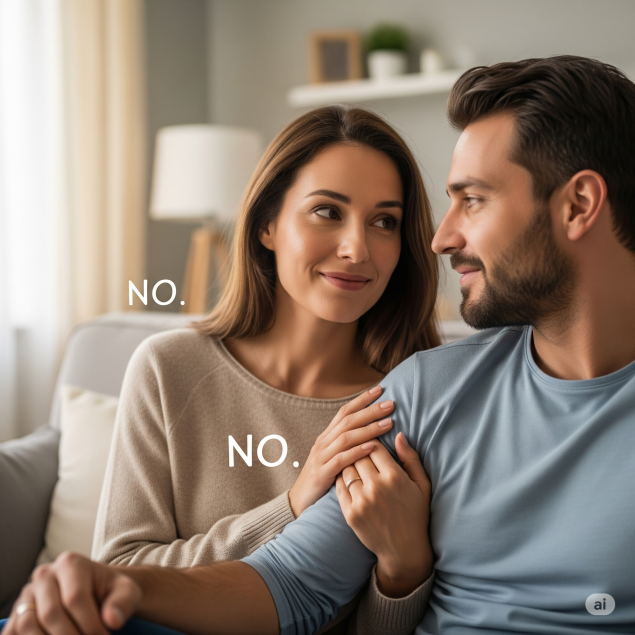161
11 Ways to Say No to Someone Without Guilt
It can be difficult to refuse a loved one, but without the ability to say “no” you will not build a healthy relationship.

Every day we encounter situations where loved ones ask us for help, favors or support. And every time there is a real drama going on inside of us: saying yes and sacrificing our interests or saying no and tormenting ourselves with guilt. Psychologists call this phenomenon “pleasant people syndrome” – a condition when a person cannot refuse others for fear of disappointing or losing their affection.
Important fact: According to the American Psychological Association, 78% of people experience stress and anxiety due to the inability to set personal boundaries in relationships. This leads to emotional burnout and a deterioration in the quality of life.
The ability to say “no” is not selfish, but a manifestation of healthy self-esteem and respect for their own needs. It is a skill that can and should be developed, especially in relationships with loved ones, where an emotional connection makes rejection particularly painful.
The Psychology of Rejection: Why It’s So Hard to Say No
The roots of our inability to refuse go back to childhood. If a child is constantly praised for obedience and willingness to help, he or she develops an attitude: “My value depends on how useful I am to others.” In adulthood, this becomes a pathological need to be needed and approved.
Neuroscientists have found that failure activates the same areas of the brain as physical pain. When we say no to a loved one, our brain interprets it as a threat to social connection, which causes discomfort and a desire to immediately correct the situation with consent.

11 Effective Ways to Say No Without Guilt
1st
The sandwich technique
Start with a positive statement, then say no, and end with a positive one. For example: You know how much I appreciate you, but right now I can’t help with the move because I have important things to do. Let's find another way I can support you.”
2.
Deferred response method
Don't give an immediate answer. Say, "Let me think until tomorrow." This time will help you weigh the pros and cons without the pressure of the moment and make an informed decision.
3
Alternative proposal
Instead of saying no, offer a compromise: “I can’t stay late at work, but I can start early tomorrow” or “I can’t borrow money, but I can help make a savings plan.”
4.
Empathy + Borders Technique
Show that you understand the other person’s feelings, but still remain firm in your decision: “I understand that it’s hard for you right now, and I’m sorry that I can’t help exactly as you ask.”
5
The "Honest Explanation" Method
Talk about your real reasons: “I’m going through a difficult time in my life and I need to focus on solving my own problems.” Sincerity often meets with understanding.
6
The "Broken Record" technique
Repeat your refusal calmly and persistently, without going into lengthy explanations. I understand, but my position has not changed. It helps when the person continues to insist.
The study found: People who learn to say no have higher levels of self-esteem and suffer less from anxiety disorders. They also build healthier and more equal relationships.
7
Time frame method
Specify a specific time when you can help: "I can't right now, but if you still need help in a week, I'll be free." This shows your willingness to help in the future.
8.
Redirection technique
Offer an alternative source of help: “I can’t help with the repair, but I know a great master” or “Ask Anna, she knows this better than I do.”
9.
Priorities method
Explain that you have more important commitments: “I’d like to help, but I have serious family commitments” or “My priority right now is health and I can’t take on the extra burden.”

10.
Appreciation for Trust Technique
Begin with gratitude: Thank you for coming to me, it means you trust me. Unfortunately, I cannot help for the following reasons ...” It mitigates rejection and shows your respect.
11.
Ecological Failure Method
Explain that rejection will benefit the relationship: “I don’t want to take on something that I can’t perform qualitatively, it will be unfair to you” or “I’d rather honestly refuse than let you down at the last minute.”
Working With Guilt: Practical Strategies
Guilt after rejection is a normal reaction, especially if you’ve lived in “always say yes” mode for a long time. It is important to understand that this feeling does not mean that you did wrong. Guilt is often the result of distorted beliefs that our worth depends on our willingness to sacrifice ourselves for others.
Guilt handling techniques: When you feel guilty, ask yourself: “What’s wrong with taking care of myself?”, “Do I have a right to my own needs?”, “Would I do the same if someone else refused me for similar reasons?”
Healthy relationships are built on mutual respect for each other’s borders. If a person can’t accept your rejection, it’s not about your “badness,” but about their inability to respect your needs.
How to prepare for a conversation
Before you say no, it is important to prepare. Determine your boundaries in advance: in which situations you are ready to help and in which you are not. Speak out loud so that it sounds natural. Remember that brevity is your ally. The more you explain and justify, the more opportunities you give the person to be pressured.
Conclusion
The ability to say no is not the art of hurting others, but the ability to build honest and healthy relationships. When you learn to set boundaries without guilt, you will not only preserve your own mental health, but also help loved ones learn to respect your needs. Remember, your “yes” is only valuable when you have the opportunity to say “no.” Start small, practice in safe situations, and gradually this skill will become a natural part of your communication.
Glossary of terms
Assertiveness is the ability to defend your rights and needs without violating the rights of others.
Personal boundaries are the psychological limits that define what we consider acceptable in the behavior of others towards us.
Pleasant people syndrome is a psychological condition in which a person experiences an irresistible need to get the approval of others.
Emotional burnout is a state of physical and emotional exhaustion caused by chronic stress.
Cognitive distortions are erroneous thought patterns that affect perceptions of reality and decision-making.
Codependency is a dysfunctional relationship model in which one person is overly dependent on the approval and needs of another.
Digital shackles: What User Agreements Hide
What is delayed pleasure and what benefits does it bring?























